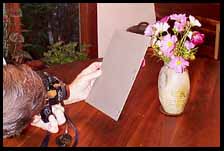Get the camera close enough
so that only the gray card shows in
the viewfinder.
Once you have the meter reading, back
off to frame the view as you like.
Be aware that automatic cameras go
back to their erroneous
ways as soon as the gray card is out
of view.
Camera light meters see reflected light,
but it is often useful to know the incident light (the light hitting your
subject). With an 18 percent gray card you can get a reflected light reading
which is essentially the same as reading incident light. Our gray cards
are made from mat board. They have been painted to give results similar
to an 18 percent reflectance Kodak gray card. This is equivalent to zone
V. In the zone system, V is the middle tone half way between black and
white.
Why do we use a gray card?
Here are several situations that benefit
greatly by the use of a gray card to check the exposure.
-
Whenever there is any sort of back lighting
such as a bright sky or window behind the subject.
-
When there is a light source such as bulb
or light fixture in front of your camera.
-
When there is any type of back light such
as a bright sky or window behind the subject.
-
When a large part of the scene has a fairly
dark tone like a close up of a big black car.
-
When a large part of the scene has a fairly
light tone like a snow scene.
These are lighting situations that fool
the typical camera light meter. It never hurts to check the light reading
with a gray card. If you get the same reading with the card as without,
you didn't need it. If the gray card gives a different reading, you should
generally use the gray card recommendation. Or, you could make several
exposures to see which negative comes out best.
Links to other web sites that explain the use of a gray card
©
Marvin
Bartel, 1998
Photo Communication
Home Art 315: Photography Home
Photo
Communication Course Information
Marvin Bartel
Home Goshen College Home
updated August 22, 1998 |





